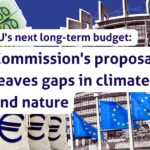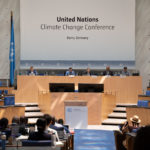To: Ministers of Finance in EU Member States, Commissioner for Budget and Administration Hahn, Executive Vice President Commissioner for Economy Valdis Dombrovskis, to the attention of EVP Commissioner for the European Green Deal Frans Timmermans
Dear Minister of Finance,
Aligning climate finance flows towards needs: Climate Action Network Europe’s recommendations to EU Finance Ministers on Climate Finance Council Conclusions
The IPCC 6th Assessment Report is clear that we are in the era of climate-induced loss and damage. This is disproportionately experienced by developing countries and communities, which also face particular challenges to adapt to climate change, meet energy access challenges and fossil fuel-free development pathways, due in part to huge financing gaps.
The financial challenge is worsened as highly indebted developing countries have to draw upon their public budgets to service debt while climate risk alongside other factors, such as the fallout from the Corona pandemic and other crises, are pushing up their borrowing costs and narrowing their fiscal space. Despite this, developed countries are not delivering on the $100 billion annual climate finance commitment made more than decade ago, and might not even meet it until 2023, not least because several developed countries are off-track in delivering on their recent pledges. There are also huge challenges to ensure climate finance does not divert official development assistance or exacerbate debt levels, and to ensure it reaches communities, supports human rights, gender equality, and local action. As the world’s largest climate finance contributor the EU should set the direction of travel for climate finance flows. Ahead of Economic and Financial Affairs Council on 4 October where Climate Finance Conclusions will be adopted, and COP27 from 6-18 November in Sharm El Sheikh, we share the following recommendations:
Addressing Loss and Damage
Even if all adaptation costs were met, there would still be significant levels of residual losses and damages from climate impacts. So far the EU’s financing has focused on averting and minimising, but not on addressing loss and damage. The EU should build on the Glasgow Dialogues and support progress towards a decision at COP27 to set up a Loss and Damage financing facility under the UNFCCC and the Paris Agreement, resourced with finance in the form of grants, with direct access modalities, to be released at speed and scale to communities affected by climate change and extreme weather events.
Scale up international climate finance to developing countries to achieve the $100 billion
The $100 billion commitment should be met on average over 2020-25 making up for shortfalls in early years of the obligation. To ensure the collective commitment is met, the EU should scale up new and additional climate finance, in the form of grants and highly concessional finance.
New and innovative sources for climate finance which also contribute to shifting financial flows include revenues from carbon taxation, levies on fossil fuel companies’ profits and partial allocation of redirected fossil fuel subsidies. The EU can tap into sources in the ‘Fit for 55’ revision: this should include allocating revenue from the Carbon Border Adjustment Mechanism (making contributions to UNFCCC funds or a new international climate fund under EU budget Heading VI) and committing to allocate an increased share of Member States’ revenues from the EU Emissions Trading System to international climate finance.
Championing Adaptation
The EU is not yet meeting the commitment to achieve a balance in mitigation and adaptation finance. As such the EU should develop a plan to do so, which can also respond to the Glasgow Climate Pact goal to double adaptation finance on 2019 levels by 2025. Especially those member states which are not achieving 50% adaptation finance should increase their share, focusing on grants. When it comes to EU budget finance, building on the adaptation shares achieved in 2014-2020 EU budget instruments and the European Development Fund, the EU should maintain and increase these flows by exceeding 60% adaptation finance in grant-equivalent terms through EU budget contributions and Global Gateway, with greater shares in Least Developed Countries and Small Island Developing States. Adaptation finance should follow the Principles of Locally Led Adaptation, and focus on building community and institutional capacity grounded in local, indigenous knowledge and science. The European Fund for Sustainable Development Plus can also play a role in building adaptive capacity across sectors: climate risk assessments and gender-responsive action plans should be required by beneficiaries of blended finance, accompanied by technical assistance.
The New Collective Quantified Goal: post-2025 climate finance
The new goal should be designed as a needs-based and science-based goal taking the format of a matrix with sub-goals including for Mitigation, Adaptation, and Loss & Damage. The new goal should prioritise grants first, then highly concessional finance, over non-concessional loans and equity (finance), potentially by establishing sub-goals for the first two desirable categories of instruments.
Supporting gender equality in the face of the climate crisis
All projects and programmes should take a gender transformative and intersectional approach and all financing should be gender responsive. The focus should be on the most disadvantaged women and minority genders, indigenous peoples, persons belonging to racial/ethnic/religious minorities, displaced, economically and socially deprived, those with disabilities, and those in rural areas.
A just and inclusive alternative to fossil fuels
The EU has repeatedly committed to phase out international public fossil fuel finance. At COP26 a number of EU Member States signed a statement on international public support for the clean energy transition. These commitments and pledge must now be implemented with integrity, encompassing international climate and development cooperation, multilateral agreements, multilateral development banks and development finance institutions, and export credits.
The EU’s Global Gateway Strategy should exclude support for fossil fuel activities and infrastructure. Energy financing should be dedicated to energy access and just transition through maximising energy efficiency and progress towards fully renewable energy systems. Just energy transition partnerships should be democratically owned, based on local expertise, knowledge, and needs, workers’ rights and target gender inclusive employment. Since climate and particularly energy projects can happen in contexts where respect for human rights and law is low, all climate financing should have robust human rights, social and environmental safeguards and follow the principle of Free, Prior and Informed Consent for affected local communities. It should consider ecosystems’ resilience, interconnection, conservation and sustainable use.
Finally, since private international finance flows dwarf public flows, any efforts to phase out fossil fuels from international public flows will be far outweighed if European finance institutions make use of the EU Taxonomy, or if the EU promotes it as an international standard in its current form, where fossil gas and nuclear activities are classified as sustainable.
We hope that you can take forward these recommendations for your consideration for orientation of international climate finance flows.
Yours sincerely,
Chiara Martinelli, Director, Climate Action Network (CAN) Europe



